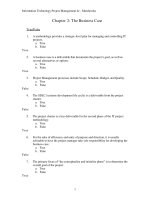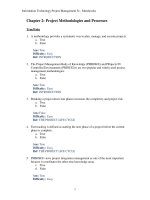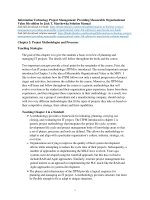Lecture Information technology project management - Chapter 6: Project cost management
Bạn đang xem bản rút gọn của tài liệu. Xem và tải ngay bản đầy đủ của tài liệu tại đây (534.32 KB, 39 trang )
Chapter 6:
Project Cost Management
adopted from PMI’s PMBOK 2000 and
Textbook : Information Technology Project Management
(author : Dr. Kathy Schwalbe)
1
Contents
• Importance of Project Cost Management
– Problem: cost overrun and cannot meet cost goals
– Costs are measured in monetary units
• Project Cost Management
– Resource planning, Cost estimating, Cost budgeting,
Cost control
• Resource Planning consideration
– difficulty, uniqueness, track record, people, equipment and
materials
• Types of cost estimate
• basic tools and techniques
• Earned value management is an important tool for cost
control
2
The Importance of Project Cost
Management
• IT projects have a poor track record for
meeting cost goals
• Average cost overrun from 1995 CHAOS
study was 189% of the original estimates;
improved to 45% in the 2001 study
• In 1995, cancelled IT projects cost the U.S.
over $81 billion
Chapter 6
3
Typical allocation of cost
4
What is Cost and Project Cost
Management?
• Cost is a resource sacrificed or foregone to
achieve a specific objective or something given up
in exchange
• Costs are usually measured in monetary units like
dollars
• This is the process group to ensure the project is
completed within the approved budget.
– The major output is the cost management plan
– There are 4 processes in Project Cost Management
Chapter 6
5
Project Cost Management Processes
• Resource planning (planning phase)
– determining what resources and quantities of them should be
used
• Cost estimating (planning phase)
– developing an estimate of the costs and resources needed to
complete a project
• Cost budgeting (planning phase)
– allocating the overall cost estimate to individual work items to
establish a baseline for measuring performance
• Cost control (control phase)
– controlling changes to the project budget
Chapter 6
6
Basic Principles of Cost
Management
• Most CEOs and boards know a lot more about
finance than IT, IT project managers must speak
their language
– Profits are revenues minus expenses
– Life cycle costing is estimating the cost of a project
over its entire life
– Cash flow analysis is determining the estimated
annual costs and benefits for a project
– Benefits and costs can be tangible or intangible, direct
or indirect
– Sunk cost should not be a criteria in project selection
Chapter 6
7
Cost of Software Defects
When Defect is Detected
User Requirements
Coding/Unit Testing
System Testing
Acceptance Testing
After Implementation
Typical Cost of Correction
$100$1,000
$1,000 or more
$7,000 $8,000
$1,000 $100,000
Up to millions of dollars
It is important to spend money upfront on IT
projects to avoid spending a lot more later.
Chapter 6
8
Resource Planning
• 8th of 21 planning phase process
• The nature of the project and the organization will
affect resource planning
• Some questions to consider:
– How difficult will it be to do specific tasks on the
project?
– Is there anything unique in this project’s scope
statement that will affect resources?
– What is the organization’s history in doing similar
tasks?
– Does the organization have or can they acquire the
people, equipment, and materials that are capable and
9
available for performing the work?
Inputs to Resource Planning
•
WBS
– identifies the project elements that require resources.
•
Historical information
– identifies required resourced used in similar work on previous project.
•
Scope statement
– contains the project justification and the project objectives.
•
Resource pool description
– identifies available project resources.
•
Organizational policies
– may impact some of the project management decision. These are
constraints, such as staffing, rentals, and purchasing supplies and
equipment.
•
Activities duration estimates
– the best estimates of the time that it will take to perform the work
– It is the output of Time Management Process: Activity Duration
10
Estimating.
Tools & techniques
• Expert judgment
– access the inputs to the process by subject
matter expect, group, or individual, including
consultants, professional or technical
associations, industrial advisory groups.
• Project management software
– help to organize resource pools, define
resource availabilities and their rates, and
define resource calendars.
11
Outputs from Resource Planning
• Resources requirement
– describes the types (e.g. skills levels) and
number of resources required by each element
of the WBS.
12
Cost Estimating
• 9th planning phase process
• collecting and predicting the costs over the life
cycle of a project or phase of a project
– developing cost estimates for all the resources needed
to complete project activities.
– An important output of project cost management is a
cost estimate
– There are several types of cost estimates and tools and
techniques to help create them
• It is also important to develop a cost management
plan that describes how cost variances will be
Chapter 6
managed on the project
13
Inputs to Cost Estimating (1)
• WBS
• Resource requirement
– Outputs from Resource Planning
• Resource rates – unit rates for each resource that
are used to calculate project costs.
• Activities duration estimates
– output of Time Management Process: Activity
Duration Estimating.
• Estimating publication
– provide commercial cost data.
14
Inputs to Cost Estimating (2)
• Historical information
– the cost of many categories of resources is available
from the following sources: a) project file; b)
commercial costestimating databases; c) project team
knowledge.
• Chart of accounts (COA)
– describes the coding structure or the budget categories
that the performing organization uses to report
financial information in its general ledger.
• Risk
– to show the importance of considering the impacts of
both opportunities and threats for costs estimates for
15
each activity
Tools & techniques
• Analogous estimating
– known as topdown
– A form of expert judgment because it uses actual costs from
previous, similar projects to estimate current costs
– Although it is less costly than other estimates, it is the least
accurate
– It is frequently used to estimate total project costs when a limited
amount of detailed information is available.
• Parametric modeling
– uses project characteristics as the parameters is a mathematical
model to predict project costs
– Models may be simple or complex (e.g. simulations using
statistics or function point analysis to estimate software
development durations)
– The costs and accuracy of parameters model vary.16
Tools & techniques (2)
• Bottom up estimating
– estimating the cost of individual activities or work
packages and then adding the individual estimates to
arrive at a project total
– Defining smaller activities or work packages increases
both the cost and accuracy of the estimate.
• Computerized tools
– Project management software, spreadsheets,
simulation tools, and statistical packages can help
estimate costs.
• Other cost estimating methods
– includes vendor bid analyses.
17
Types of Cost Estimates
Type of Estimate
Rough Order of
Magnitude (ROM)
Budgetary
Definitive
When Done
Very early in the
project life cycle,
often 3–5 years
before project
completion
Early, 1–2 years out
Why Done
How Accurate
Provides rough
ballpark of cost for
selection decisions
–25%, +75%
Puts dollars in the
budget plans
–10%, +25%
Later in the project, < Provides details for
1 year out
purchases, estimate
actual costs
Chapter 6
18
–5%, +10%
Outputs from Cost Estimating
• Cost estimates
– Quantitative assessments of the likely costs of the resources
required to complete project activities. Cost estimates types
include
•
•
•
•
preliminary estimate
budget estimate
analogy estimates
definitive and control estimates
• Supporting details
– include description of the scope of work estimated, reference to
WBS, the basis of the estimate, assumptions, and the range of
possible results.
• Cost management plan
– describe how cost variances will be managed. It is part of the
19
project plan.
Constructive Cost Model
(COCOMO)
• Prof Barry Boehm helped develop the COCOMO
models for estimating software development costs
– a famous parametric model for software development
industry
– Parameters include source lines of code or function
points (these two are common parameters to measure
the complexity of a program)
• COCOMO II is a computerized model available
on the web
• Boehm suggest that only parametric models do
not suffer from the limits of human decision
making
Chapter 6
20
Typical Problems with IT Cost
Estimates
• Developing an estimate for a large software project is a
complex task requiring a significant amount of effort.
– Remember that estimates are done at various stages of the project
• Many people doing estimates have little experience doing
them.
– Try to provide training and mentoring
• People have a bias toward underestimation
– Review estimates and ask important questions to make sure
estimates are not biased
• Management wants a number for a bid, not a real
estimate.
– Project managers must negotiate with project sponsors to create
realistic cost estimates
Chapter 6
21
Cost Budgeting
• 10th of 21 planning process
• It is the process of allocating cost estimates to
individual work activates
– Cost budget involves allocating the project cost estimate
to individual work items and providing a cost baseline
– For example, in the Business Systems Replacement
project, there was a total purchased costs estimate for
FY97 of $600,000 and another $1.2 million for
Information Services and Technology
• The project budget is the planned cost of each
activity at the lowest level, which is then rolled
into a project total. Chapter 6
22
Inputs to Cost Budgeting
• Cost estimates
– output from cost estimates process
• WBS
– output from scope definition process
• Project schedule
– includes planned start and expected finish dates for
the activities or work packages in order to allocate
costs.
• Risk management plan
– A part of the project plan that contains procedures to
manage risk throughout the project.
23
Outputs from Cost Budgeting
• Cost baseline
– A timephased budget that will be used to measure
and monitor cost performance on the project
– It is developed by summing estimated costs by period
and is usually displayed in the form of an Scurve
– Larger projects may have multiple cost baselines to
measure different aspects of cost performance.
24
Cost Control
• 5th of 8 controlling phase process
• Project cost control include
– monitoring cost performance
– ensuring that only appropriate project changes are included in a
revised cost baseline
– informing project stakeholders of authorized changes to the project
that will affect costs
• During this process, project manager try to determine what
facts impact, cost, how these factors can be influenced,
whether these changes are beneficial to the project or
product.
• Earned value management (EVM) is an important tool for
cost control
Chapter 6
25









